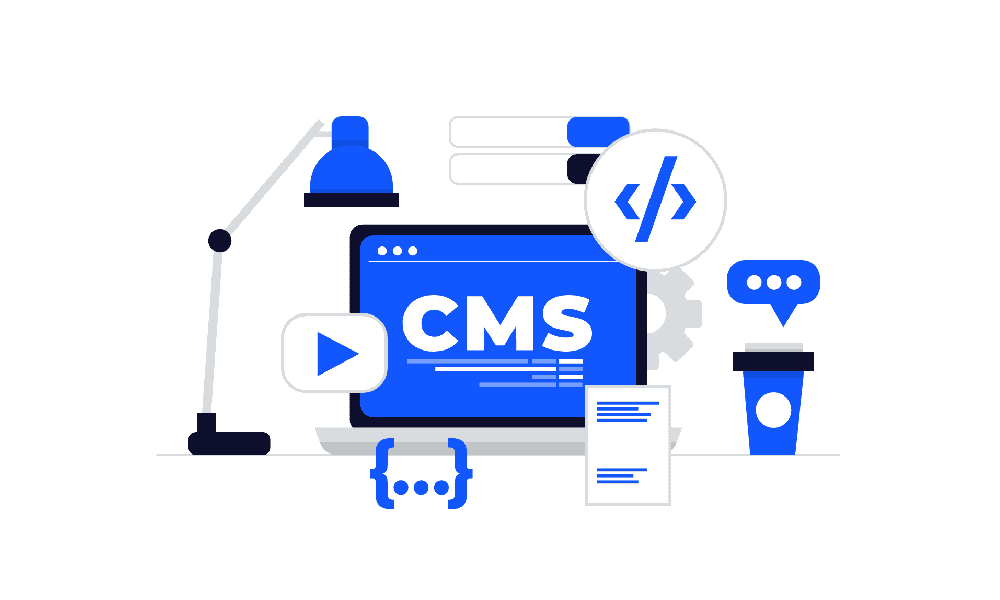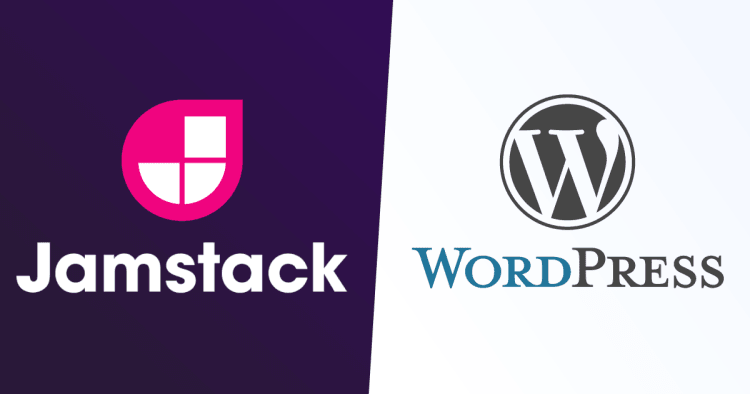Reliability, performance, and security are essential attributes we look for when building a new web product. While our expectations from a web product haven’t changed, web technologies have changed tremendously over the years.
It hasn’t been long since web development moved from HTML and CSS to Content Management Solutions such as WordPress. Although developers everywhere still find WordPress extremely cool, a new trending web technologies stack called Jamstack has recently gained popularity.
So, if you plan to launch a new web product for your business, should you use Jamstack or WordPress?
Let’s understand how Jamstack and WordPress are different and which of them should be the best choice for your business.
Jamstack vs WordPress: An Overview
Here’s what we must first know about WordPress and Jamstack.
WordPress is one of the simplest and most popular CMS for creating websites and blogs. With an extensive ecosystem of themes and plug-ins available, you do not need any coding knowledge to get your WordPress website up and running. That’s why it is preferred by many. In fact, out of all the CMS-built sites, 64.1 percent are WordPress sites.
Technically speaking, WordPress is open-source, which means anyone can use it for free. It uses a LAMP stack approach for web development based on the Linux OS, Apache HTTP Server, MySQL database, and PHP.
Jamstack, on the other hand, is a modern web development architecture based on JavaScript, reusable APIs, and Markup.
Jamstack does not refer to any specific software technology or platform. Instead, it is a way of building faster, secure, and more scalable websites.
Jamstack is an alternative to the traditional monolithic and server-side software development practices followed by CMS such as WordPress.
Jamstack vs WordPress: The Key Differences
Comparing Jamstack to WordPress is like comparing apples to oranges.
However, what is comparable is that they both are approaches you might follow when building a web product. So, here's how they both differ.
1. Fundamental Difference
Jamstack is an architectural web development philosophy that encourages static files on CDNs (Content Delivery Networks) and JavaScript-accessed services for any dynamic needs.
On the other hand, WordPress is an all-in-one solution to build websites—a CMS (content management system) based on the LAMP stack.
While Jamstack is modular by design, WordPress is monolithic.
2. Developer Experience

Web developers get a better experience with Jamstack. For example, they can pick JavaScript libraries and frameworks and use modern tools like Babel and Webpack.
Moreover, setting up a great development environment becomes easy with static site generators such as Gatsby and Hugo.
Another point that makes Jamstack attractive for developers is that the site’s code is not stored on a server. Instead, it is stored in a repository like Git. When any changes are made to the code, the repository keeps track of those changes and makes it easy to revert to any previous versions if needed.
If other developers need to collaborate on the project, they can pull down the code from Git onto their local environment for further alterations. This means no complex installs are required.
On the other hand, WordPress is easy to use and does not require any programming knowledge. Therefore, it's an excellent solution for anyone with no programming skills.
However, it does not offer the developer experience provided by Jamstack because everything is stored on the server. Besides, running WordPress locally is tricky, and developers are on their own for site deployment.
3. Data Integration
Jamstack makes it possible to feed data to digital platforms using a secure API and have instant control over your data at all times.
In WordPress, the data is stored within the platform, and it cannot be easily extracted or shared with other platforms. Furthermore, WordPress organizes the content in webpage-oriented frameworks, making it difficult for the same content to adapt to other digital platforms.
4. Security

Because of third-party vulnerabilities, WordPress has become infamous for its security issues. As a result, its sites are often the favorite targets of hackers.
The Sucuri 2019 Threat Research Report tells us that WordPress was infected slightly more often in 2019 than in the previous year. The infection rates of WordPress grew from 90% to 94%.
WordPress users have to search for security packages and updates regularly.
Jamstack sites are much more secure because they are static and are hosted on CDNs.
And since they don’t have dynamic interactions with a server, they are less vulnerable to malicious attacks.
Moreover, Jamstack separates the front end of the web projects from the back end.
5. Performance
Performance is an essential metric for ranking websites. This is one aspect where Jamstack sites fare better than WordPress sites.
WordPress is based on server-side rendering, which is slow. The use of outdated technologies and coding languages such as PHP makes WordPress slow. In addition, developers have no control over what is rendered by slow and old third-party plugins. This makes it nearly impossible to optimize WordPress sites.
Jamstack delivers pre-built static files that are optimized even before users load them. Developers have complete control over everything that is served to the client—this makes optimizing Jamstack websites easier than WordPress.
Considering recent Google Core Web Vitals and Page Experience updates, Jamstack can really help you ramp up your overall website or web app speed.
6. Content Management
Content management in WordPress is built into the platform. It combines the content and presentation layers, making it difficult to manage and use the same content across multiple media channels.
Jamstack provides several possibilities for managing content, including “headless” content management systems (CMS).

A headless CMS allows you to easily add content to a website from the admin panel. The content is then sent to the source code's repository or stored in a self-hosted server.
A static site can fetch this data via an API. How the information is displayed is controlled entirely by the front end.
7. Pricing
It's pretty simple to set up a basic WordPress website. However, as you add more features and functions, costs quickly ramp up. This is because of WordPress's limited ability to scale.
For Jamstack, the initial costs for setting up sites are slightly higher than WordPress. Jamstack is an architecture and requires more work to set up. However, these costs even out in the long run because adding new features takes less time to implement with Jamstack.
When to Choose Jamstack Over WordPress?
WordPress began its journey as a pure blogging platform but later evolved into a multi-purpose website creator offering a vast ecosystem of themes and plugins. Unfortunately, this transformation has limited its performance, scalability, security, and development.
Jamstack is an architecture designed to fix issues with WordPress sites.
Choose it when:
- Safety is a big issue – Jamstack helps develop static websites with zero plugins or databases. Such sites are like fortresses against cyberattacks. Plus, a secure site means fewer security expenses.
- Great user experience is needed – Jamstack sites do away with generating page views on the server at request time. This improves page loading time, impacting the user experience.
- The site needs to be scaled later – Jamstack sites make it possible to cache everything in a content delivery network. With easy deployments, built-in redundancy, and unmatchable load capacity, Jamstack sites make scalability easy.
- Portability is a requirement – As Jamstack sites are pre-generated, you can host them from a wide range of hosting services. It is not tricky to later move them to any other preferred host.
When to Choose WordPress Over Jamstack?
Jamstack is not always the right choice for all projects, despite all the appealing features.
You must opt for WordPress when:
- Quick website building is needed, and you lack technical knowledge – With the suitable themes and plugins at your easy disposal, you can have a professional, functioning website up and running in no time.
- An easy update is required – WordPress is handy to control and update everything without coding. However, when updating a Jamstack site, you need the developer's help.
- Huge variety of plug-ins – WordPress offers a wide range of plugins to develop your website.
Notable Jamstack Web Development Examples
1. Strane
Strane is a part of Holistic Industries, a "Greenhouse of Brands." The client approached Imaginovation for custom website development and implementation, and we suggested the client go with Jamstack. They were quite impressed with the final output.
2. Garcia Hand Picked
Garcia Hand Picked is also part of Holistic Industries. The client was really impressed with the Strane web development implementation, so they insisted on going with Jamstack for this project too.
Develop a Website or Web App: Choosing the Right Web Architecture with Imaginovation
Whether you plan to build your website or web app on WordPress or use a Jamstack approach, we support both environments.
Contact us at Imaginovation. We will suggest the right architecture for building your web product.
Imaginovation is an award-winning web development company with vast experience crafting remarkable digital success stories for diverse companies. Let's talk.
Ready to build an app, but not sure where to start?
We've got you covered. Click the button below to get started.





